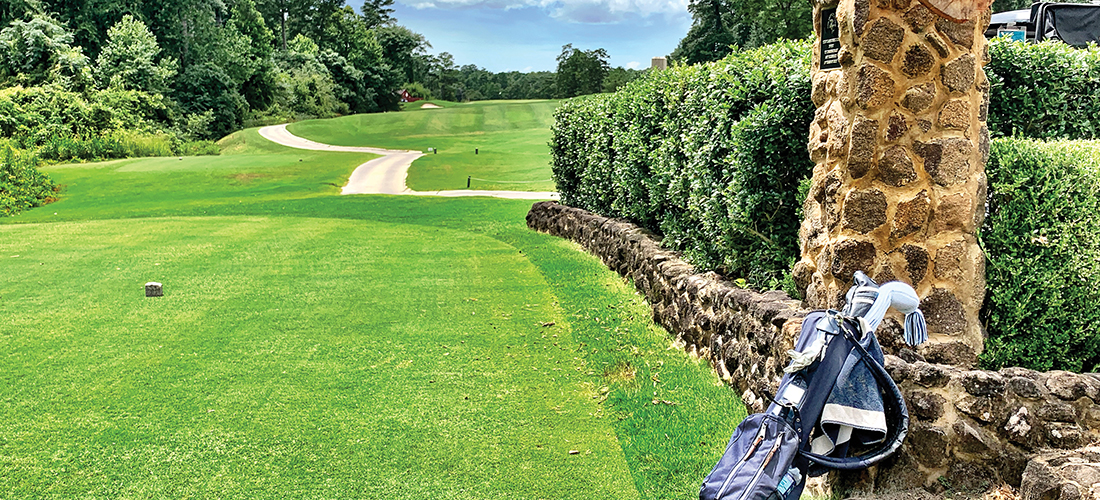
Down Highway
A gem sparkles in Aiken
By Lee Pace
Before Henry Flagler laid the first railroad tie or built the first ornate hotel room in South Florida, before James Walker Tufts scraped his first rudimentary golf hole out of the sandy loam around Pinehurst, there was Aiken, South Carolina, a small town built on a plain just 15 miles from Augusta, Georgia, and along a key intercontinental railroad stop connecting the major cities of the East to New Orleans.
At first they came in the summertime just after the Civil War from Charleston and surrounds to escape the threats of malaria and yellow fever. Then in the 1880s it became all about the horses — riding, breeding, playing polo, running steeplechases. Streets were named Ruffian and Saratoga. The clay-based soil was ideal for horses’ hooves and traction, the winter temperatures were mild, and the area’s mineral springs thought to be health-giving. There were tennis courts and ample wild game roaming the woods. The Vanderbilts, Goodyears, Appletons, Pinkertons, Graces and Astors wintered there. Kings and presidents visited.
Aiken was Palm Beach before there was a Palm Beach.
Golf followed as well, first at Palmetto Golf Club in 1892 with a four-hole course that expanded to a regulation 18 by 1895; and then at Highland Park Golf Club in 1912, that course built as an amenity to a new hotel and residential community that has an interesting connection to the Tufts family, Donald Ross and Pinehurst.
Pinehurst, Camden and Aiken shared the common heritage of being perfectly located circa 1900 to offer warmer winter weather within one day’s train ride from New York, Philadelphia, Boston and other northern climes. This was before Florida had evolved and certainly long before the advent of commercial air traffic. The train coming from the north passed through Raleigh, went to Southern Pines, and from there it was 90 miles to Camden and another 80 to Aiken.
The Kirkwood Hotel was located in Camden next to the train station and was a 200-room facility that boasted among its amenities in 1903 a nine-hole golf course. Walter Travis, a three-time U.S. Amateur champion who dabbled in course design in the early 1900s, redesigned the original course, and then Ross visited in 1938 to reconfigure the layout known today as Camden Country Club and convert the greens from sand to grass.
“Camden is one of the special places in the Carolinas,” says Charleston’s Frank Ford III, an accomplished Charleston golfer with multiple championships on state and regional levels. “I’ve had a love affair with that golf course since the first time I saw it. It’s just so much harder than it looks.”
Following James Tufts’ death in 1902, Leonard Tufts took over the operation of the village of Pinehurst. He knew that beyond the resort amenities themselves, convenient accessibility was paramount to being successful in the travel business. The planning, construction and maintenance of good highways became an interest and priority of Tufts, who led the resort until his retirement in 1929, when he turned the reins over to son Richard.
Leonard was the moving force in building what became Midland Road, connecting the train station in Southern Pines to Pinehurst. At various junctures he would serve as president of the Capital Highway Association and the U.S. Good Roads Association. He was also chairman of the Moore County Good Roads Committee.
The Atlantic Highway was part of the original National Highways Association created by the federal government in 1911 to create and maintain some 50,000 miles of public highways. The Atlantic linked Maine to Miami and was the precursor to U.S. Highway 1. The road ran from the north through Southern Pines and turned southwest toward Camden, Aiken and Augusta before veering south toward Savannah.
Tufts by virtue of his perch on these important highway boards could see where opportunities lie. And one area of exploration he thought was to have a series of resort hotels along this key highway running into South Carolina.
A group of Aiken businessmen in 1912 launched a company to build a hotel, golf club and real estate project on the site of the original Highland Park Hotel, a grand destination with 125 rooms operating from the late 1860s until burning down in 1898. They did so with some unknown degree of consultation, encouragement and perhaps even financial investment from Tufts. The course opened with 11 holes in 1912 and expanded to 18 three years later as Highland Park Golf Club, and remains in business today as Aiken Golf Club.
“Building hotels and golf courses along Highway 1 was big business in the early 1900s,” says course owner Jim McNair Jr., who inherited the course from his father and personally led a restoration and rebuilding effort in the late 1990s. “We found old newspaper stories talking about Leonard Tufts visiting and helping put a deal together. At the time, no one thought the South was good for anything but resorts — getting people down from the North out of the cold.”
Donald Ross by 1910 was devoting his time almost exclusively to designing golf courses across the eastern United States and apparently was going to route and build the course at Aiken. But his schedule was too jammed, so a fellow Scottish golf pro who had immigrated to the United States named John Inglis did the work with input from Ross. The fortunes of the Highland Park Hotel and its golf course followed that of many enterprises in the Roaring ’20s — success out of the gate and then a devastating collapse in the early 1930s. The town of Aiken eventually took the property over, tore down the hotel and sold the golf course to Jim McNair, a top amateur golfer of the mid-1900s and winner of the Carolinas Amateur in 1946 and ’48.
McNair Jr. took the operation over in 1986 following his father’s retirement and spent a decade noodling ideas of how to improve the facility and bring back some of the early design features from Inglis and Ross. He pursued Bill Coore and Ben Crenshaw in the mid-1990s to visit the course and consider a restoration job, and Coore looked at the course in 1997 when in town to visit Palmetto Golf Club, which sits just a mile and a half away. McNair took Coore’s advice and suggestions to renovate the course “in-house,” and over two years, McNair and his crew removed some 10,000 trees, rebuilt the greens, put in a new irrigation system, and crafted some broad swaths of sand and assorted vegetation.
“We’ve got more than a century of tradition and have a fun, accessible golf course,” McNair says of his daily fee operation. “But we’re still not the oldest club in town.”
Today AGC is a terrific experience with a $27 weekend green fee, its 5,800-yard, par-70 measurements belying the challenge of hitting off uneven lies all day and navigating the small and quirky greens (there is even a links-style double green for the first and 17th holes) and the twists and turns through the surrounding neighborhood. It’s on the National Register of Historic Places and is replete with stories like the stone and grass staircase leading from the tee of the par-3 16th down to the green. The curious dimensions of the staircase — requiring at least one or two extra steps at each level before going down the next riser — prompted dancing virtuoso Fred Astaire to navigate them with a makeshift tap dance when he played there during the winter entertainment season.
The evolution of Florida in the first half of the 1900s certainly changed the winter resort business in the South. But fortunately both Palmetto and Aiken Golf Club have survived all manner of economic and wartime obstacles and remain viable today, each with its own niche in a golf-rich environment that includes the shadow of Augusta National down Interstate 20 and another ultra-private club just outside of Aiken, the Tom Fazio-designed Sage Valley.
Less than a quarter of a mile to the east of the first tee of Aiken Golf Club is U.S. Highway 1, and tracing the left side of the first five holes is the railroad, keeping the Pinehurst-Camden-Aiken connection viable today. PS
Lee Pace’s adventures exploring many of the interesting old golf courses of the Carolinas will be included in a forthcoming book from UNC Press, Good Walks—Strolling Across the Carolinas Golf Landscape, due out in 2020.





